POWER SUPPLIES
Hey kids, we need to talk about power supplies!
Power supplies are one of those subjects that are subject to a tsunami of misinformation from either well meaning but ill informed internet 'experts', or businesses trying to sell you something massively overpriced that you don't need, so we thought we'd write a tutorial on what actually matters.

The main areas to look at are:
Voltage / V- Yes, your power supply unit (PSU) voltage has to be in vaguely the correct ballpark, but with the majority of music kit its really not going to matter if you use a 12v PSU on a unit that specifies a 9v input. The overwhelming majority of music kit is actually running on a lower voltage than the PSU delivers, but has internal power circuitry that reduces and stabilises the input to the internal voltages that the unit actually runs on. On most kit powered by external supplies this is often a 5v and/or 12v rail internally, but as long as the external PSU delivers at least 2.5v or so more than the internal voltage rails then it'll work fine. A machine that specifies a 9v external PSU is probably running on 5v internally, so it'll most likely run ok on a supply delivering anything from 7.5v to 12v. Any more than that and things might start to get a bit warm as the extra voltage is dissipated as heat, but that depends on many factors. Bear in mind that older unregulated linear power supplies (the heavy ones that are essentially a mains transformer in a box) can often be measured as delivering ridiculously excessive voltages when they aren't under load. Measure the output of a 9v unregulated linear PSU when its not plugged into anything and its not unusual to see around 14v. In theory when they are powering something the voltage drops to more like the specified value, but its a very hit and miss affair so kit is usually designed to run under a wide range of conditions.
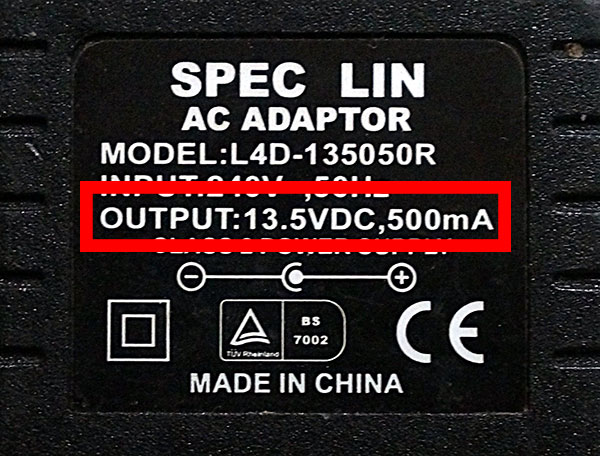
A completely imaginary output rating . Measures 19v not under load. Could be virtually anything under load depending on what its actually powering
While we're on the subject, power supplies with ridiculously specific voltages aren't actually a thing! There is no such thing as a 10.5v PSU, a 9.3v PSU, a 13.5v as shown above, or any number of unlikely voltages we've seen. If your kit supposedly needs 10.5v its just the manufacturer trying to convince people that they have to buy the massively overpriced official PSU, as they won't be able to find a 10.5v supply anywhere else because they don't really exist. If a piece of kit was so badly engineered that it needed an absurdly specific 9.3v PSU or it'd go up in flames, then thats not a piece of kit anyone should be buying. A 9v supply will work perfectly well.
Current / mA - This is one of the most misunderstood power supply issues. Basically the mA (milliamps) rating on a normal PSU is how much current the supply is potentially capable of delivering, not how much it continuously delivers. Any piece of electronic kit will only ever pull as much current as it needs and as long as that amount is within the capacity of the PSU, plus maybe 100-150mA for headroom, then it'll work fine. Under normal circumstances you cannot damage a piece of electronic kit by using a PSU with a higher mA rating than specified by the unit in question. If a piece of kit specifies a 500mA supply, then it probably only actually uses about 250-300mA at the absolute maximum. You could use a 750mA supply, or a 1A (1000mA) one, or probably even a 400mA one at a push, but its usually better to go higher rather than lower.
Polarity - The polarity of your power supply is important. Unless your PSU has a weird connector then it will be either centre positive or centre negative.
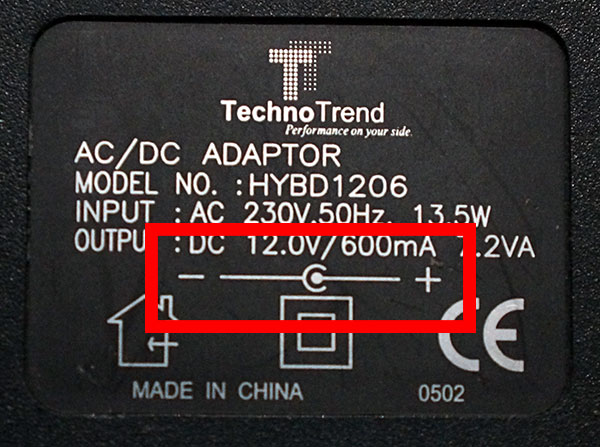 |
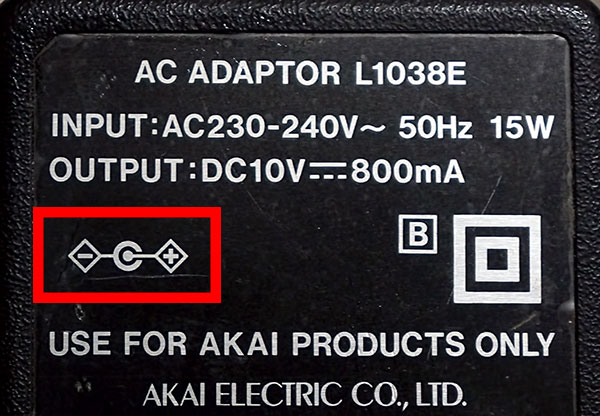 |
A couple of centre positive diagrams. That 'use for Akai products only' bit is obviously horseshit.
The majority of companies these days seem to use centre positive supplies, but companies like Roland / Boss, Casio and Zoom have traditionally used centre negative supplies, and all guitar pedals tend to be centre negative for reasons to do with the way that battery power used to be switched in and out that we won't go into here.
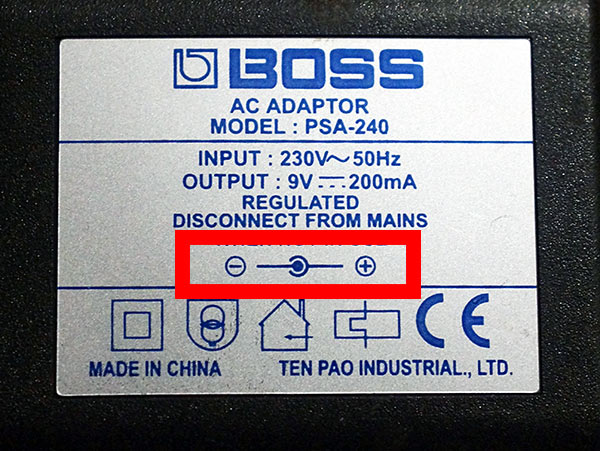
Centre negative diagram on a Boss PSU.
The 'centre' bit there refers to whether the inside of a power plug barrel is positive or ground. Any decently made piece of kit for the last 40 years should have built in polarity protection, so within reason plugging in a power supply of the wrong polarity shouldn't matter. Having said that, if you are unsure of polarity and you're trying something out for the first time, if it doesn't turn on then its probably not a good idea to just leave it sitting there with reversed polarity power! Pull it out quickly and try the other way.
Only AC/DC power supplies have polarity. AC/AC ones don't. See below.
AC or DC - THIS CAN BE THE KILLER! There are two main types of power supply, AC/DC and AC/AC. AC/DC are the normal common everyday supplies that come with most kit. The supply converts AC (alternating current) voltage from the mains into low voltage DC (direct current) that is used to power most electronic gear. An AC/DC PSU will probably have a + and - polarity diagram on the case as part of the output specs as shown above, where as an AC/AC one will usually, but not always have a picture of a wavy line as they don't have a specific polarity.
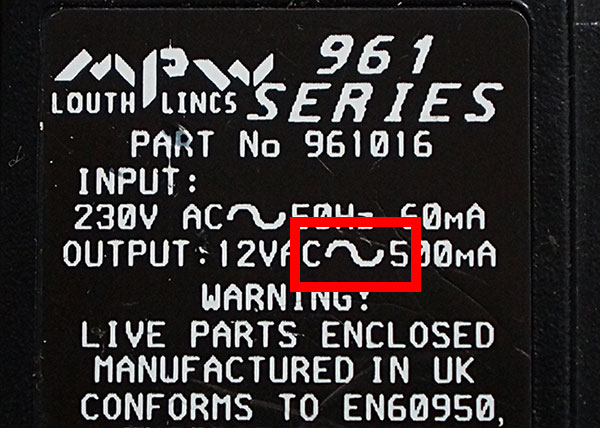
AC output symbol. This may not be present but it will say VAC at a minimum.
There are various reasons why companies might use AC/DC or AC/AC supplies, but its mainly due to what kind of internal power rails their designs use. Some companies such as Alesis and Lexicon have always been very keen on using AC/AC PSU's, and you'll often see Digitech Whammy pedals up on ebay as 'spares or repair' as people try to power them with a DC supply when they need an AC one, and assume they aren't working!
The main issue is that while using a DC PSU on a machine that wants an AC one probably isn't going to harm it, using an AC PSU on something that wants a DC one is very possibly going to end up with a horrible burning smell and some expensive repair work. Using a DC PSU on a machine that wants an AC one might actually give the impression that the machine is working but there won't be any sound. This is a common issue with the Alesis HR16 where a 9v DC PSU will make it light up and appear to be working as the digital side runs fine on either DC or AC, but you want get any sound as the audio output sections need AC.
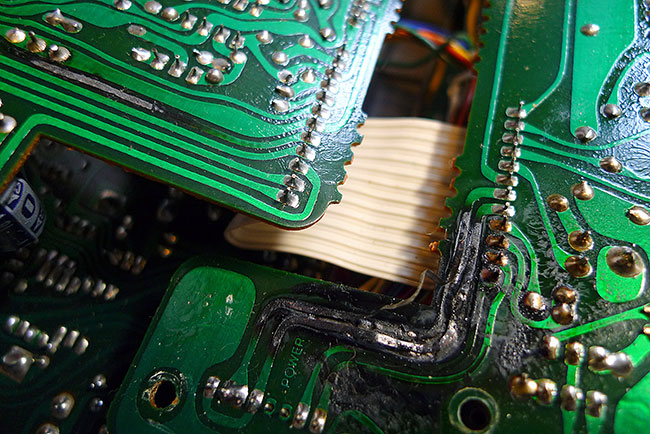
PCB tracks literally burnt off the board on a Roland SH101 after someone used an AC/AC power supply.
If in doubt NEVER use an AC/AC PSU if you don't know for sure that its needed. They are becoming increasingly rare on modern kit due to manufacturers finding other ways to generate the internal power rails that they were traditionally needed for, but you still see them on some units.
Lets not even talk about the MB33 rackmount synth that says it needs 12v AC on the back, but also has a DC PSU polarity diagram, and some units were supplied with a 15v DC supply as its runs perfectly well on either and never really needed an AC supply at all......
The basic things to take away from this are that you really don't need to be that precise about power supply choices as power is power wherever its sourced from, and theres whole industries grown up to prey on people lack of knowledge. On ebay theres pages and pages of listings for massively overpriced power supplies that are supposedly for specific units, but they are all identical. Theres no difference between a 9v 1A Chinese PSU for a Danelectro distortion pedal, the same thing being sold for a specific Korg synth, and the generic 9v 1A PSU you can buy for a fifth of the price with no specific piece of kit named.
We would also question the idea of power supply 'quality' in many cases, as this can often just take the form of a music kit website or reseller just putting their own sticker on a generic power supply and quadrupling the price.
Our final suggestion would be to always be suspicious of the power supply recommendations of guitar people! If theres one group of people who are borderline audiophiles when it comes to outright gullability in even vaguely technical matters, and are happy to believe all kinds of absolute horseshit as long as it has a high enough price tag and a lot of convincing pseudoscience, its guitar people. ;-)
Yes, we know that some of the principles or concepts stated in this tutorial maybe aren't strictly 100% electronically accurate and there are always other factors involved or exceptions to the rules, but you don't need to email to tell us! We are aware of these things, but we're trying to make this as simple as possible for everyone to understand.





